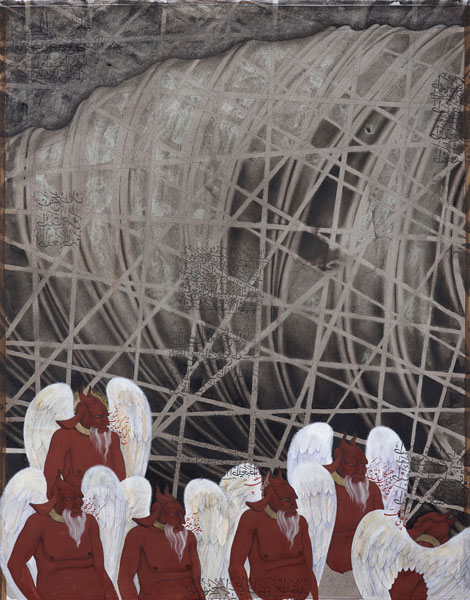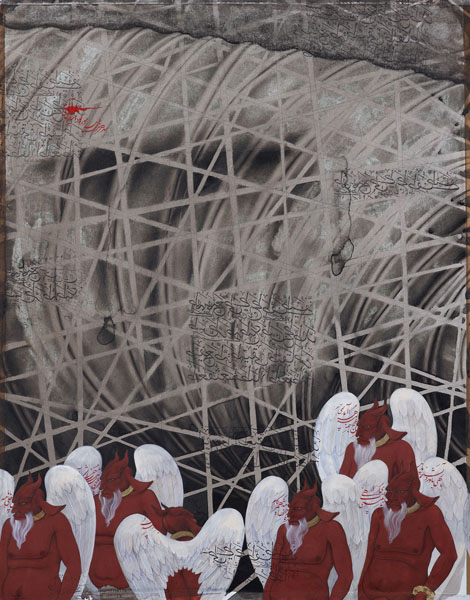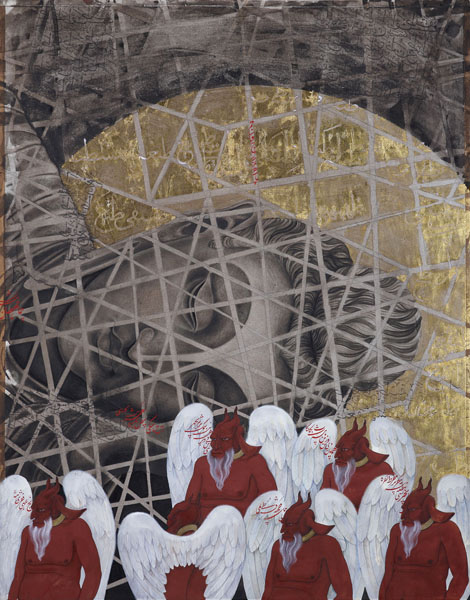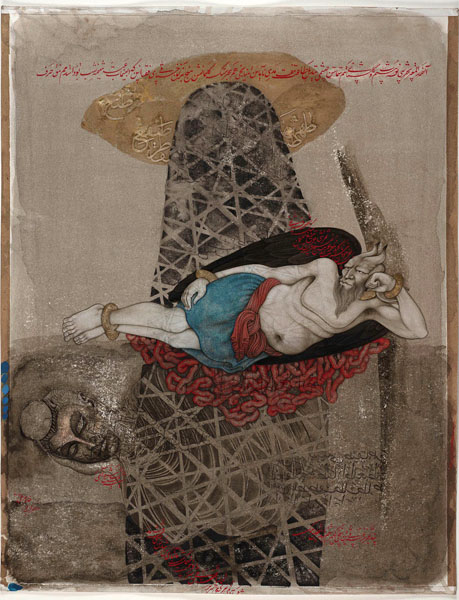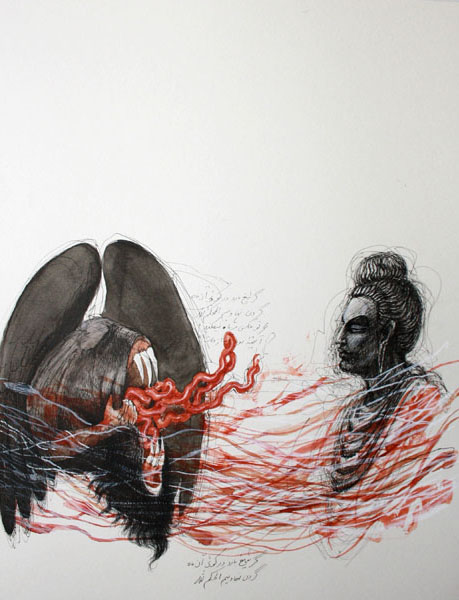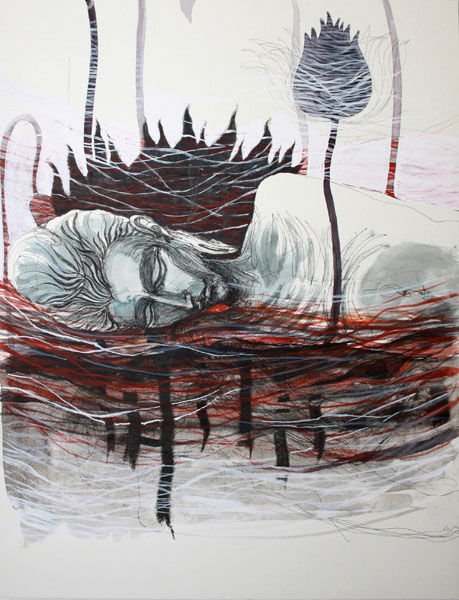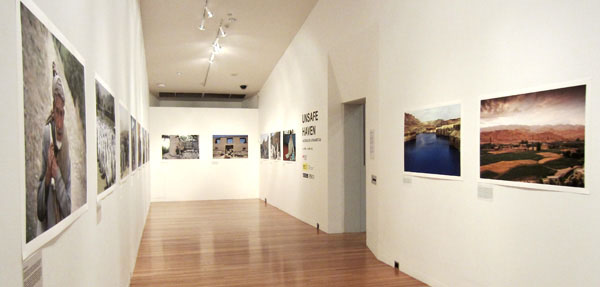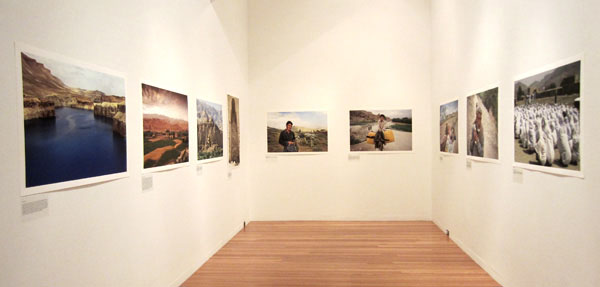
Khadim Ali: Haunted Lotus — 10 to 12 May 2012
Talk on Saturday, 12 May 2012 at 3pm by Prof Ian Howard, Dean, College of Fine Arts, UNSW
Preview from 10 to 12 May 2012
Artwork featured in The Haunted Lotus: Contemporary Art from Kabul
Artwork featured in The Haunted Lotus: Contemporary Art from Kabul
Artwork featured in The Haunted Lotus: Contemporary Art from Kabul
Artwork featured in The Haunted Lotus: Contemporary Art from Kabul
Khadim Ali’s miniature painting work explores complex moral themes of good and evil, set in the anarchic civil war in Afghanistan, where ethnic and religious bigotry are means to an end. Khadim Ali interweaves past and present symbols — including the Taliban’s destruction in 2001 of the Bamiyan Buddhas sculpted by his Hazara ancestors — to explore coexisting layers of the experience of intervention and religious extremism in a world distorted by warped ideologies.
To render common pain and commemorate the persecution and massacre of the Hazara minority in Afghanistan, Khadim Ali draws on scenes from the Shanamah, or the Book of Kings, the Persian national epic composed in the late tenth and early eleventh centuries and revered by generations since. As a child growing up in exile in Quetta, Ali was captivated by his grandfather’s readings of the epic poem (of some 50,000 couplets), crossing kingdoms and centuries. He knows by heart Firdausi’s verses and images as well as Bihzad’s works in the Safavid tradition. In Firdausi’s masterpiece, the hero Rustam is the embodiment of virtue and honour through glorious deeds, but tragically kills his son in battle. Following the Shanamah, Khadim Ali presents universal master narratives of victory and defeat, hope and despair alongside personal loss and displacement.
In the context of Afghanistan, Taliban propagandists declared themselves to be the new ‘winged Rustam’ — omnipresent and with eyes everywhere — to mythologise their violence. In 2001 after the desecration at Bamiyan, Khadim Ali was baffled to find semi-literate Taliban fighters, known for their hostility to Persinate culture, identifying as Rustam-like holy warriors. His dark, scarred painted panels present this inverted Rustam as an ambiguous figure, glorying in beauty but sinister. In an allusion to the Taliban, his bloated demons have monster’s faces, horns and goat’s ears (a reference to nomadic collaborators) and dance over the charred but still potent space where the Buddhas stood. Haunted Lotus, takes its title from a poem by Asad Budah, a revered contemporary Afghan poet, philosopher and activist and introduces a new element: the idea of a third Buddah buried in the soil of Bamiyan.
Like Firdausi centuries before him, Ali chronicles the displacement and loss of those, like the Hazara people, born on the ‘wrong side of history’. As he says: ‘Our times are not romantic. I’m doing something against ignorance. I want my art to be for the sake of humanity’. (Quote from Virgina Wiles, Art and Polemic in Pakistan.) Ali’s reflective and philosophical conversations are also about what it means to be Afghani and an asylum seeker.
Artwork featured in The Haunted Lotus: Contemporary Art from Kabul
Artwork featured in The Haunted Lotus: Contemporary Art from Kabul
Artwork featured in The Haunted Lotus: Contemporary Art from Kabul
About Khadim Ali
Khadim Ali lives in Sydney and works in Quetta and Kabul. He is an Afghan Hazara born in Pakistan who took up Australia as his primary residence in 2010. He trained in miniature painting at the National College of Arts, Lahore (his mentor was Imran Qureshi), and is a participant in the contemporary miniature painting movement which emerged from Pakistan in the 1990s. Australian audiences have seen his profound work in Contemporary Miniatures, a Queensland Art Gallery touring exhibition and the 2011-2012 Blake Prize Touring Exhibition (won by Kahled Sabsabi with Khadim Ali highly commended). Khadim Ali has curated several exhibitions on contemporary Afghan art and politics at The Cross Art Projects in Sydney (and touring).
Khadim Ali has exhibited in museums and biennales including the Fukuoka Asian Art Museum, Japan; the Asia Pacific Triennial, Queensland Art Gallery; East West Divan, Venice Biennale 2009 and the forthcoming documenta13 in June 2012. Since it was established in 1955, the Documenta exhibition has been regarded as a key international exhibition of contemporary art worldwide and a moment of reflection on the relationship between art and society. It takes place every five years and runs for 100 days. This version, documenta13, brings together about 140 artists, including several Australians.
Only from the heart can you touch the sky
RMIT Gallery, Melbourne, 12 April to 9 June 2012
Presented with The Cross Art Projects
Drawing its title from a poem by Movlana Jalal al-Din Rumi, the celebrated 13th century Persian mystic poet, Only From The Heart Can You Touch The Sky focuses on the fusion of art and poetry. We are invited to step outside the frame of conflict and reflect on the fact that people arriving in Australia as refugees are the inheritors of living cultures.
The exhibition shows the interweaving in Persian culture of image, verse, song and weaving and features paintings by Hazara artists Khadim Ali (Australia-Afghanistan) and Ali Baba Aurang (Afghanistan), calligraphy by Iranian poet and playwright Mammad Aidani (Melbourne), combined with nineteenth century rugs.
Khadim Ali’s minature paintings draw on literary masterpieces and traumatic contemporary political events. Kabul-based Ali Baba Aurang has been creating calligraphic art for 20 years, trained in Iran and is celebrated for siamask calligraphy in central Asia and in Australia (curated by Khadim Ali). Mammad Aidiani (Melbourne) has researched and published on the Iranian diaspora, belonging, identity, and migration, and responds to the artworks using freeform poetry in Persian script.
Installation view Only from the heart, RMIT Gallery, 2012. Showing Khadim Ali
Installation view showing Mammad Aidiani wall work
Unsafe Haven: Hazaras in Afghanistan
RMIT Gallery, Melbourne, 12 April to 9 June 2012
Also showing at RMIT Gallery is the touring exhibition Unsafe Haven: Hazaras in Afghanistan, a powerful and timely travelling exhibition by former refugee Abdul Karim Hekmat whose photos and reportage on the lives of Hazara people in Afganistan provide an insight into their devastated daily world. Unsafe Haven challenges the view that Afghan asylum seekers no longer need protection.
Since January 2001, a Memorandum of Understanding between the Australian Government, the Government of Afghanistan and the United Nations High Commissioner for Refugees permits the involuntary repatriation from Australia of unsuccessful Afghan asylum-seekers. The agreement includes provision for sending back unaccompanied minors and Afghan children separated from their families. The ethnic minority Hazaras are especially vulnerable because of their religious belief. The exhibition is timely as, in the past months, the general security situation in Aghanistan has continued to deteriorate. The exhibition has toured with Amnesty International, Refugee Council of Australia and UTS Sydney.
Artwork featured in The Haunted Lotus: Contemporary Art from Kabul
Artwork featured in The Haunted Lotus: Contemporary Art from Kabul
Only Love and Devotion: from Persia and Beyond
State Library of Victoria 9 March to 1 July 2012
Only from the heart can you touch the sky, is in association with Love and devotion: from Persia and Beyond at the State Library of Victoria. As a timely reminder of the sophistication and cultural legacy of the region, Love and devotion: from Persia and Beyond consists of nearly 70 rare 13th to 18th century Persian, Mughal Indian and Ottoman Turkish illustrated manuscripts and miniatures from the Bodleian Libraries, Oxford.
Download and links


